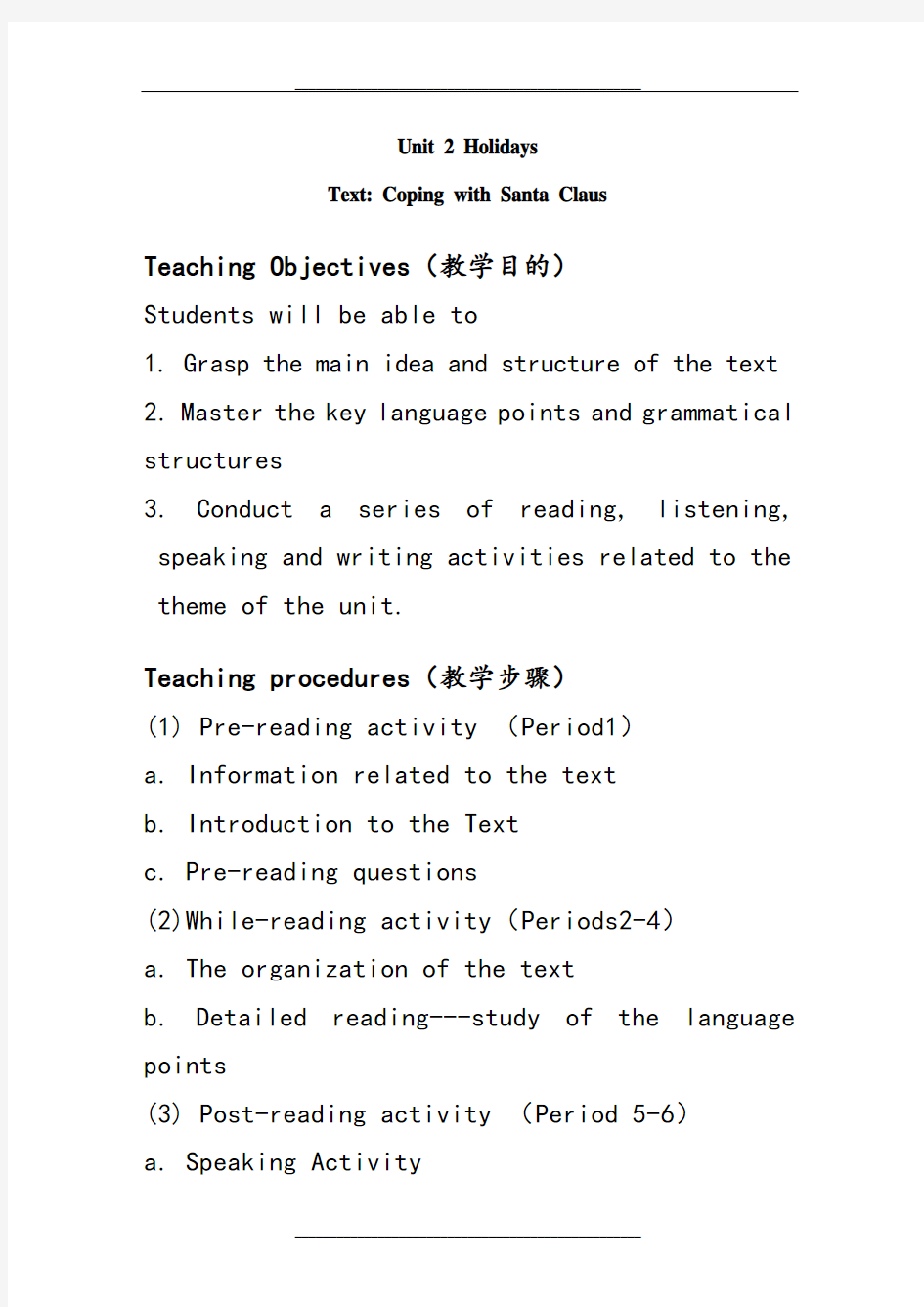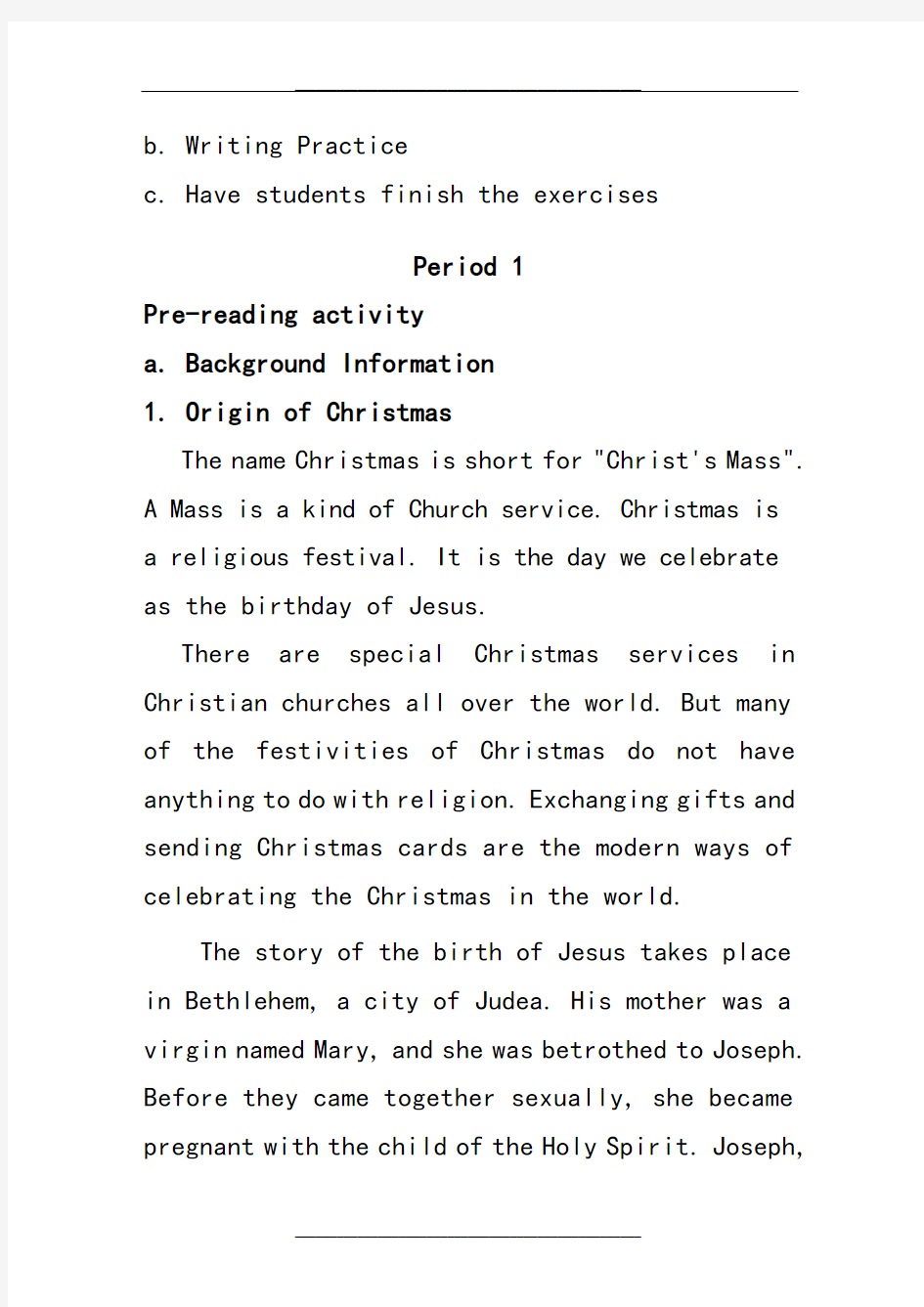创新大学英语1-2教案


Unit 2 Holidays
Text: Coping with Santa Claus
Teaching Objectives(教学目的)
Students will be able to
1. Grasp the main idea and structure of the text
2. Master the key language points and grammatical structures
3. Conduct a series of reading, listening, speaking and writing activities related to the theme of the unit.
Teaching procedures(教学步骤)
(1) Pre-reading activity (Period1)
a. Information related to the text
b. Introduction to the Text
c. Pre-reading questions
(2)While-reading activity(Periods2-4)
a. The organization of the text
b. Detailed reading---study of the language points
(3) Post-reading activity (Period 5-6)
a. Speaking Activity
b. Writing Practice
c. Have students finish the exercises
Period 1
Pre-reading activity
a. Background Information
1. Origin of Christmas
The name Christmas is short for "Christ's Mass".
A Mass is a kind of Church service. Christmas is a religious festival. It is the day we celebrate as the birthday of Jesus.
There are special Christmas services in Christian churches all over the world. But many of the festivities of Christmas do not have anything to do with religion. Exchanging gifts and sending Christmas cards are the modern ways of celebrating the Christmas in the world.
The story of the birth of Jesus takes place in Bethlehem, a city of Judea. His mother was a virgin named Mary, and she was betrothed to Joseph. Before they came together sexually, she became pregnant with the child of the Holy Spirit. Joseph,
not yet her husband, was told to hide her away. While he thought about these things, Gabriel, an angel of the Lord, appeared to him in a dream and told him not to be afraid to take Mary as his wife, and that Mary would bring forth a Son, and he shall call his name, Jesus, for he would save his people from their sins. Joseph agreed to marry and protect Mary, and to raise Jesus as his son.
As Mary and Joseph were travelling to Joseph’s family’s hometown, Bethlehem, for a census, the time for Mary to deliver the child approached. They made it as far as Bethlehem, where Mary gave birth. She wrapped Him in swaddling clothes, and laid Him in a manger, because there was no room for them in the inn, as many travelers were on their way home for census. Today, Christmas, as the feast of the nativity of Jesus, is celebrated on the 25th of December every year. Nobody knows the actual birth of Jesus. 2. Christmas Celebrations
Santa Clause and his Gifts
Gift-giving is a near-universal part of
Christmas celebrations. In many countries, children leave empty containers for Santa to fill with small gifts such as toys, candy, or fruit. In the USA and the UK, children hang a Christmas stocking by the fireplace on Christmas Eve, because Santa is said to come down the chimney the night before Christmas to fill them. In other countries, children place their empty shoes out for Santa to fill on the night before Christmas, or for Saint Nicholas on December 6th. Gift-giving is not restricted to these special gift-bringers, as family members and friends also bestow gifts on each other.
Christmas Cards
Christmas cards are extremely popular in the United States and Europe, in part as a way to maintain relationships with distant relatives and friends, and with business acquaintances. Many families enclose an annual family photograph, or a family newsletter telling activities of family members during the preceding year.
Decorations
Decorating a Christmas tree with lights and ornaments, and decorating the interior of the home with garlands and evergreen foliage, particularly holly and mistletoe, are common traditions. In North and South America and to a lesser extent Europe, it is traditional to decorate the outside of houses with lights, and sometimes with illuminated sleighs, snowmen, and other Christmas figures.
Social Aspects and Entertainment
In many countries, businesses, schools, and communities have Christmas parties and dances during the several weeks before Christmas Day.
On Christmas Day or on Christmas Eve, a special meal of Christmas dishes is usually served, for which there are traditional menus in each country. In some regions, particularly in Eastern Europe, these family feasts are preceded by a period of fasting. Candy and treats are also part of the Christmas celebration in many countries.
3. Origin of the Christmas Tree
Although it is generally agreed that the Christmas tree in its current form came from Germany in the early 19th century, the tradition of decorating a tree to mark winter celebrations dates back hundreds of years to Roman times, when the Romans used to decorate evergreen trees with small pieces of metal to celebrate Saturnalia.
Legend also suggests that, in the late 16th century, Martin Luther (the founder of the protestant religion) was the first to decorate an indoor tree with candles when he attempted to recreate the stars shinning over a forest of evergreens.
The first mention of decorated trees being taken indoors came in 1605 in Germany—a country with a long Christmas tree history! The trees were initially decorated with fruit and sweets together with hand-made objects such as quilted snowflakes and stars. German Christmas markets began to sell shaped gingerbreads and wax ornaments which people bought as souvenirs of the fair and took home to hang on their trees.
Artificial trees were invented in the 1880’s in a bid to try and stop some of the damage being caused to real trees due to people lopping the tip off large trees, thus preventing the trees from growing any further. It got so bad in Germany that laws had to be brought in to prevent people having more than one tree.
Prince Albert, husband of Queen Victoria, is credited with being responsible for introducing the custom of the Christmas tree to the British public by decorating the first English Christmas tree at Windsor Castle in 1841 using candles, sweets, fruit and gingerbread.
The popularity of Christmas tree grew in Britain during the first half of the 20th century, with trees becoming bigger and more elaborately decorated with bells, baubles and tinsel.
4. Rudolph
Rudolph is depicted as an ordinary reindeer with a large, red nose, often grinning and always leading the team pulling Santa’s sleigh, which
